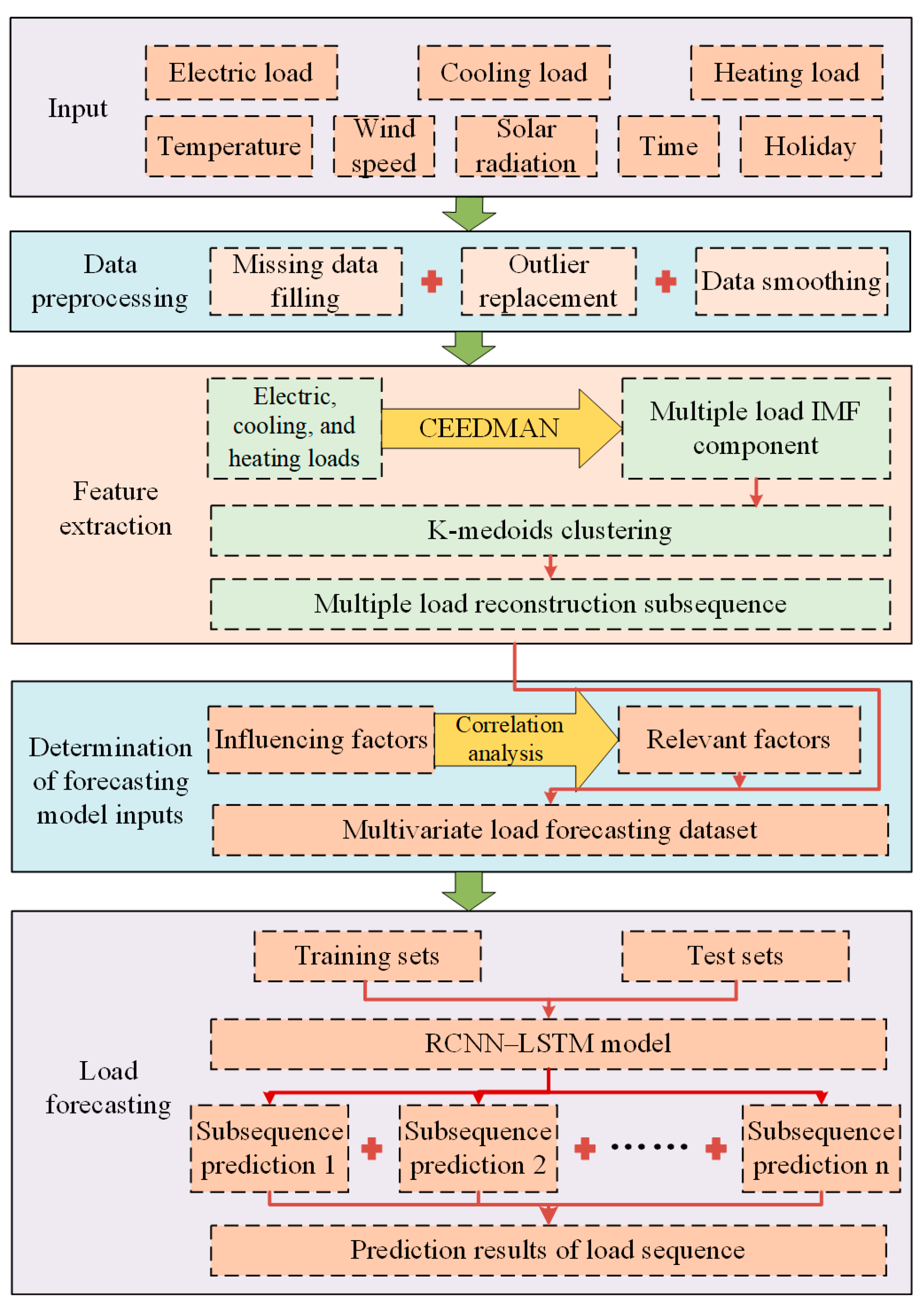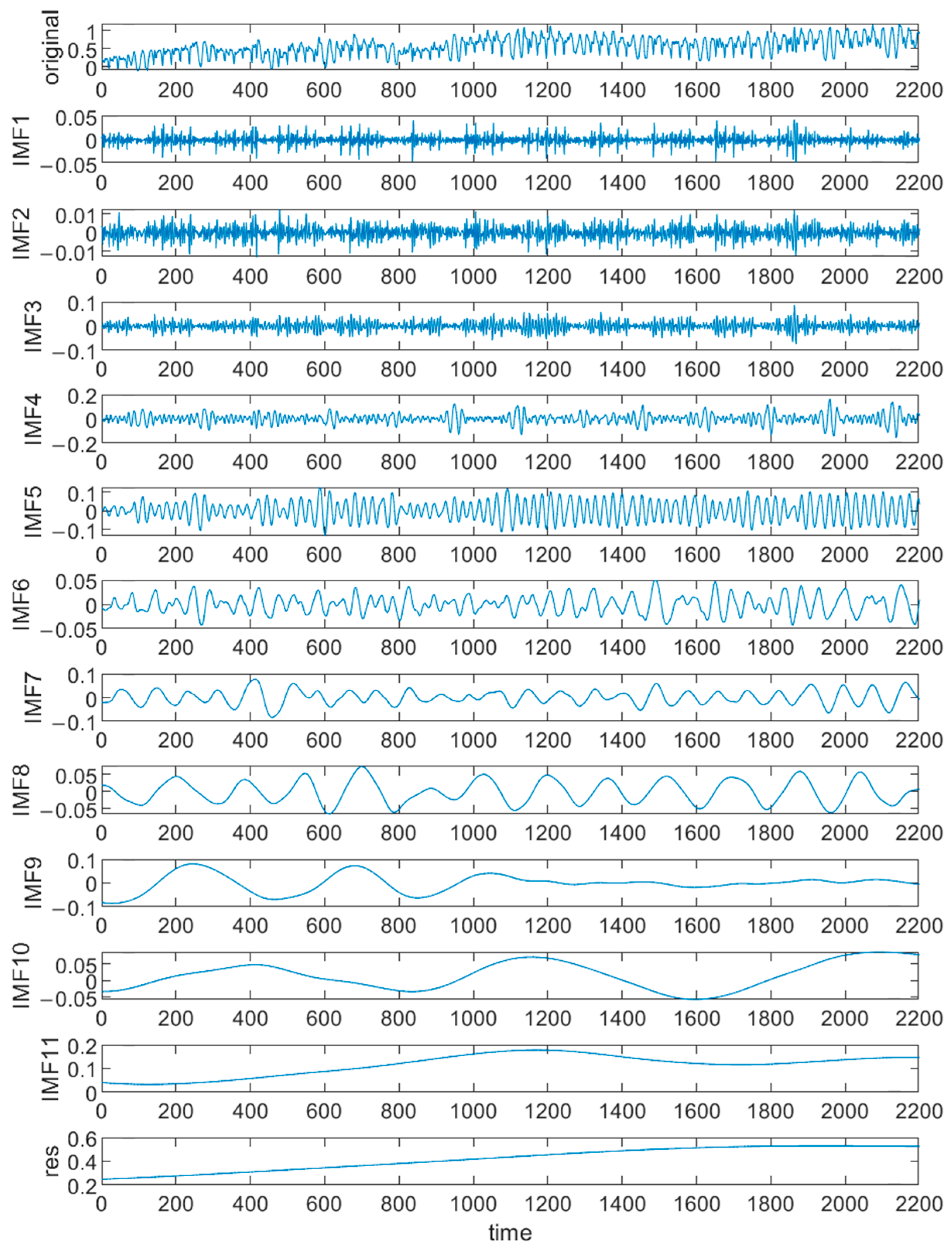Collaborative Forecasting of Multiple Energy Loads in Integrated Energy Systems Based on Feature Extraction and Deep Learning
Abstract
1. Introduction
2. Correlation Analysis Between Loads and Influencing Factors in Integrated Energy Systems
2.1. Correlation Analysis Between Loads
2.2. Correlation Analysis Between Load and External Factors
3. Load Feature Extraction Based on Data Decomposition and Clustering
3.1. Theory Related to Data Decomposition
3.1.1. Composition of System Loads
3.1.2. Complete Ensemble Empirical Mode Decomposition with Adaptive Noise
3.2. K-Medoids Clustering Based on Dynamic Time Warping
3.2.1. Algorithmic Process
3.2.2. Evaluation Index of Clustering Algorithm
4. Load Forecasting Model
4.1. Load Forecasting Based on Multi-Task Learning
4.2. Deep Learning Theory
4.2.1. Regression Convolutional Neural Network
4.2.2. Long Short-Term Memory Network
4.3. Collaborative Forecasting Model of Multiple Loads
4.3.1. Construction of Forecasting Model
4.3.2. Evaluation Index
4.3.3. Forecasting Process
5. Case Study
5.1. Prediction Example
5.2. Analysis of Results
6. Conclusions
Author Contributions
Funding
Data Availability Statement
Conflicts of Interest
References
- Yu, X.D.; Xv, X.D. A Brief Review to Integrated Energy System and Energy Internet. Trans. China Electrotech. Soc. 2016, 31, 1–13. [Google Scholar]
- Sun, D.; Liu, Z.; Shao, J.; Lin, Z. Review on low carbon planning and operation of integrated energy systems. Energy Sci. Eng. 2022, 10, 3201–3215. [Google Scholar] [CrossRef]
- Zhu, J.; Dong, H.; Zheng, W.; Li, S.; Huang, Y.; Xi, L. Review and prospect of data-driven techniques for load forecasting in integrated energy systems. Appl. Energy 2022, 321, 119269. [Google Scholar] [CrossRef]
- Ding, N.; Benoit, C.; Foggia, G.; Besanger, Y.; Wurtz, F. Neural network-based model design for short-term load forecast in distribution systems. IEEE Trans. Power Syst. 2016, 31, 72–81. [Google Scholar] [CrossRef]
- Cheng, H.; Hu, X.; Wang, L.; Liu, Y.; Yu, Q. Review on research of regional integrated energy system planning. Autom. Electr. Power Syst. 2019, 43, 2–13. [Google Scholar]
- Zhou, N.; Liao, J.; Wang, Q.; Li, C.; Li, J. Analysis and prospect of deep learning application in smart grid. Autom. Electr. Power Syst. 2019, 43, 180–191. [Google Scholar]
- Chen, H.; Wang, J.; Tang, B.; Xiao, K.; Li, J. An integrated approach to planetary gearbox fault diagnosis using deep belief networks. Meas. Sci. Technol. 2017, 28, 180–191. [Google Scholar] [CrossRef]
- Deng, D.Y.; Li, J.; Teng, Y.; Huang, Q. Short-term electric load forecasting based on EEMD-GRU-MLR. Power Syst. Technol. 2020, 44, 593–602. [Google Scholar]
- Zhang, Y.M.; Sun, M.; Ji, X.Q. Short-term load forecasting of integrated energy system based on modal decomposition and multi-task learning model. High Volt. Eng. 2025, 51, 1–18. [Google Scholar]
- Zhu, J.; Dong, H.; Li, S.; Chen, Z.; Luo, T. Review of Data-driven Load Forecasting for Integrated Energy System. Proc. Chin. Soc. Electr. Eng. 2021, 41, 7905–7924. [Google Scholar]
- Shi, J.Q.; Tan, T.; Guo, J. Multi-Task Learning Based on Deep Architecture for Various Types of Load Forecasting in Regional Energy System Integration. Power Syst. Technol. 2018, 42, 698–707. [Google Scholar]
- Luo, F.; Zhang, X.; Yang, X.; Yao, Z.; Zhu, L.; Qian, M. Load analysis and prediction of integrated energy distribution system based on deep learning. High Volt. Eng. 2021, 47, 23–32. [Google Scholar]
- Xiao, Y.; Zhao, Y.; Tu, Z.; Qian, B.; Chang, R. Topology checking method for low voltage distribution network based on improved Pearson correlation coefficient. Power Syst. Prot. Control. 2019, 47, 37–43. [Google Scholar]
- Zhao, H.L.; Zhang, D.D.; Huang, S.; Mo, S.; Wei, H. Analysis on the Relation Between Cloud-to-ground Lightning Density and Lightning Trip Rate in Hainan Province Based on Pearson Correlation Coefficient. High Volt. Appar. 2019, 55, 186–192. [Google Scholar]
- Yang, N.; Li, H.; Yuan, J.; Li, S.; Wang, X. Medium-and long-term load forecasting method considering grey correlation degree analysis. Proc. CSU-EPSA 2018, 30, 108–114. [Google Scholar]
- Aguiar-Pérez, J.M.; Pérez-Juárez, M.Á. An Insight of Deep Learning Based Demand Forecasting in Smart Grids. Sensors 2023, 23, 1467. [Google Scholar] [CrossRef] [PubMed]
- Lu, Z.; Jie, G.; Lu, M. Short-term load forecasting for integrated energy system based on coupling features and multi-task learning. Autom. Electr. Power Syst. 2022, 46, 58–66. [Google Scholar]
- Cho, K.; Van Merriënboer, B.; Gulcehre, C.; Bahdanau, D.; Bougares, F.; Schwenk, H.; Bengio, Y. Learning Phrase Representations using RNN Encoder-Decoder for Statistical Machine Translation. arXiv 2014, arXiv:1406.1078. [Google Scholar]
- Zhuang, J.; Tang, T.; Ding, Y.; Tatikonda, S.C.; Dvornek, N.; Papademetris, X.; Duncan, J. AdaBelief optimizer: Adapting stepsizes by the belief in observed gradients. In Proceedings of the Neural Information Processing Systems (NeurIPS), Virtual, 6–12 December 2020; Volume 33. [Google Scholar]
- Li, R.; Sun, F.; Ding, X.; Han, Y.; Liu, Y.P.; Yan, J.R. Ultra short-term load forecasting for user-level integrated energy system considering multi-energy spatio-temporal coupling. Power Syst. Technol. 2020, 44, 4121–4131. [Google Scholar]
- Ye, J.H.; Cao, J.; Yang, L.; Luo, F.Z. Ultra short-term load forecasting of user level integrated energy system based on variational mode decomposition and multi-model fusion. Power Syst. Technol. 2022, 46, 2610–2622. [Google Scholar]
- Zhu, L.; Wang, X.; Ma, J.; Chen, Q.; Qi, X. Short-term load forecast of integrated energy system based on wavelet packet decomposition and recurrent neural network. Electr. Power Constr. 2020, 41, 131–138. [Google Scholar]
- Sun, X.; Li, J.; Zeng, B.; Gong, D.; Lian, Z. Small-sample day-ahead power load forecasting of integrated energy system based on feature transfer learning. IET Control Theory A 2021, 38, 63–72. [Google Scholar]
- Li, N.; Jiang, Y.; Huang, S.; Mao, L. Short-Term Load Forecasting Based on ARIMA Transfer Function Model. Power Syst. Technol. 2009, 33, 93–97+103. [Google Scholar]
- Tan, M.; Hu, C.; Chen, J.; Wang, L.; Li, Z. Multi-node load forecasting based on multi-task learning with modal feature extraction. Eng. Appl. Artif. Intel. 2022, 112, 104856. [Google Scholar] [CrossRef]
- Wu, C.; Yao, J.; Xue, G.; Wang, J.; Wu, Y.; He, K. Load forecasting of integrated energy system based on MMoE multi-task learning and LSTM. Electr. Power Autom. Equip. 2022, 42, 33–39. [Google Scholar]












| Load Series | Composition of Reconstruction Subsequence |
|---|---|
| C1 | IMF1, IMF2, IMF3, IMF4 |
| C2 | IMF9, IMF10, IMF11, RES |
| C3 | IMF5, IMF6, IMF7, IMF8 |
| Load Series | Cooling Load | Heating Load | Wind Speed | Solar Radiation | Temp | Time | Holiday |
|---|---|---|---|---|---|---|---|
| C1 | 0.760 | 0.340 | 0.356 | 0.333 | 0.376 | 0.233 | 0.333 |
| C2 | 0.785 | 0.413 | 0.446 | 0.648 | 0.689 | 0.656 | 0.569 |
| C3 | 0.816 | 0.372 | 0.340 | 0.334 | 0.303 | 0.434 | 0.334 |
| Load Series | Influencing Factor |
|---|---|
| C1 | Cooling load |
| C2 | Cooling load, heating load, wind speed, solar radiation, temp, time, holiday |
| C3 | Cooling load, time |
| Season | Date Type | Load Type | MAPE/% | MA/% | WMA/% |
|---|---|---|---|---|---|
| Summer | Working day | Cooling | 2.24 | 97.76 | 97.67 |
| Heating | 2.75 | 97.25 | |||
| Electric | 1.69 | 98.31 | |||
| Rest day | Cooling | 2.40 | 97.60 | 97.32 | |
| Heating | 3.21 | 96.79 | |||
| Electric | 2.16 | 97.84 |
| Season | Date Type | Load Type | MAPE/% | MA/% | WMA/% |
|---|---|---|---|---|---|
| Winter | Working day | Cooling | 2.92 | 97.08 | 97.60 |
| Heating | 1.66 | 98.34 | |||
| Electric | 2.87 | 97.13 | |||
| Rest day | Cooling | 2.08 | 97.92 | 97.79 | |
| Heating | 1.88 | 98.12 | |||
| Electric | 3.12 | 96.88 |
| Season | Date Type | Load Type | MAPE/% | ||
|---|---|---|---|---|---|
| Proposed Model | Scenario 1 | Scenario 2 | |||
| Summer | Working day | Cooling | 2.2420 | 9.3546 | 4.6862 |
| Heating | 2.7489 | 7.6739 | 4.2642 | ||
| Electric | 1.6882 | 9.6367 | 5.1323 | ||
| Rest day | Cooling | 2.4010 | 9.5923 | 5.5553 | |
| Heating | 3.2114 | 8.6851 | 4.6650 | ||
| Electric | 2.1628 | 9.2516 | 4.9009 | ||
| Winter | Working day | Cooling | 2.9202 | 9.3546 | 3.4080 |
| Heating | 1.6633 | 7.6739 | 3.6309 | ||
| Electric | 2.8721 | 9.6367 | 5.7045 | ||
| Rest day | Cooling | 2.0787 | 8.5504 | 4.7295 | |
| Heating | 1.8837 | 7.8862 | 5.0586 | ||
| Electric | 3.1156 | 8.7932 | 4.6766 | ||
Disclaimer/Publisher’s Note: The statements, opinions and data contained in all publications are solely those of the individual author(s) and contributor(s) and not of MDPI and/or the editor(s). MDPI and/or the editor(s) disclaim responsibility for any injury to people or property resulting from any ideas, methods, instructions or products referred to in the content. |
© 2025 by the authors. Licensee MDPI, Basel, Switzerland. This article is an open access article distributed under the terms and conditions of the Creative Commons Attribution (CC BY) license (https://creativecommons.org/licenses/by/4.0/).
Share and Cite
Wang, Z.; Duan, J.; Luo, F.; Qiu, X. Collaborative Forecasting of Multiple Energy Loads in Integrated Energy Systems Based on Feature Extraction and Deep Learning. Energies 2025, 18, 1048. https://doi.org/10.3390/en18051048
Wang Z, Duan J, Luo F, Qiu X. Collaborative Forecasting of Multiple Energy Loads in Integrated Energy Systems Based on Feature Extraction and Deep Learning. Energies. 2025; 18(5):1048. https://doi.org/10.3390/en18051048
Chicago/Turabian StyleWang, Zhe, Jiali Duan, Fengzhang Luo, and Xiaoyu Qiu. 2025. "Collaborative Forecasting of Multiple Energy Loads in Integrated Energy Systems Based on Feature Extraction and Deep Learning" Energies 18, no. 5: 1048. https://doi.org/10.3390/en18051048
APA StyleWang, Z., Duan, J., Luo, F., & Qiu, X. (2025). Collaborative Forecasting of Multiple Energy Loads in Integrated Energy Systems Based on Feature Extraction and Deep Learning. Energies, 18(5), 1048. https://doi.org/10.3390/en18051048








